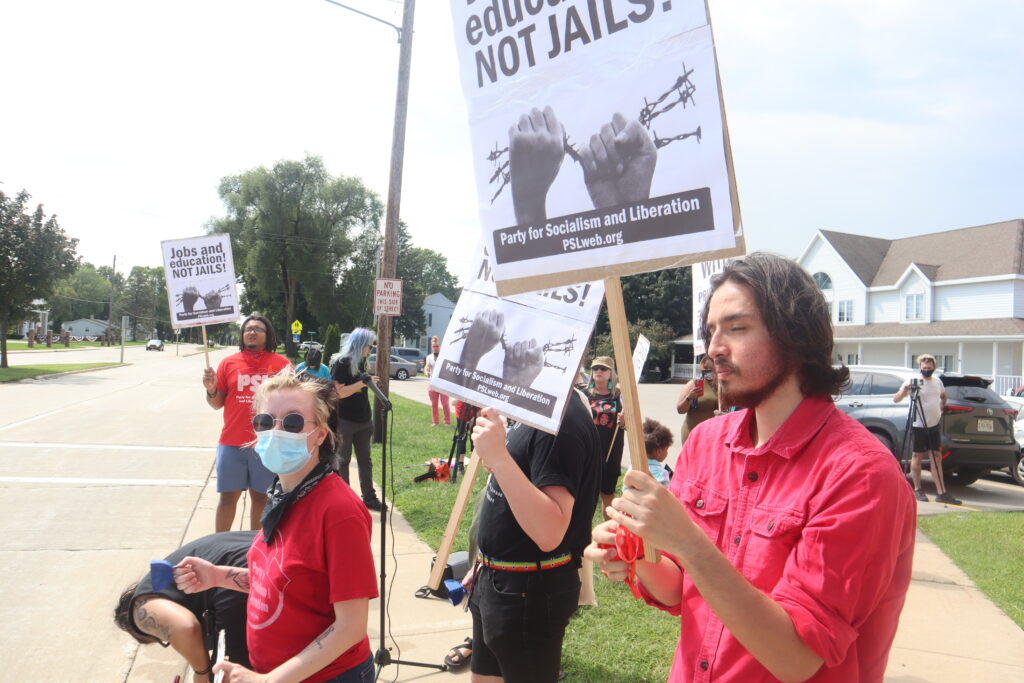State Has Nation’s 2nd Highest Racial Disparity in Imprisonment
Report: Wisconsin's Black residents 11.8 times more likely than whites to be jailed.

Activists gather outside of Green Bay’s prison for a rally in September 2021. Photo by Isiah Holmes/Wisconsin Examiner.
Wisconsin continues to incarcerate its residents — especially African Americans — at rates far outpacing other states and even other countries. According to a new Prison Policy Initiative analysis, the Badger State locks up its Black residents, who make up just 6% of the state’s population, in state prisons at a rate of 11.8 times that of white residents. Only the state of New Jersey had a higher rate of incarceration for Black residents, 11.9 times the rate for white residents.
In international comparisons, Wisconsin incarcerates 663 people per 100,000 population in its prisons, jails, immigration detention and juvenile justice facilities, compared with 129 in the United Kingdom, 111 in Portugal and 104 in Canada.
Every U.S. state, the analysis found, incarcerates Black residents in state prisons at higher rates than white residents. The state of Connecticut’s state prison incarceration rates were just behind Wisconsin’s, with the rate for Black residents 9.9 times that of white residents.
Wisconsin’s criminal justice system has long had some of the highest incarceration rates of minority residents nationwide. Over 20,000 people are held within the Department of Corrections (DOC) facilities in Wisconsin, according to the most recent population report.
Three of the state’s four maximum security facilities are overcrowded; the Green Bay Correctional Institution is the only exception. The Dodge Correctional Institution, for example, holds just shy of 1,600 people when it was designed to only hold 1,165. In Waupun, where the state’s oldest prison is located, over 1,000 people are held in a facility designed to hold 882. The same is true for many of the state’s medium and minimum security facilities, from Fox Lake, where there are 1,174 people in a facility built to hold 979 , to Oshkosh where a prison built for just under 1,500 people is holding over 2,000.
Overcrowding and under-staffing have led to chronic problems at many of the prisons. Last month, an investigation by Wisconsin Watch in partnership with the New York Times revealed deteriorating conditions in the Waupun Correctional Institution as the prison continued a months-long lockdown. People held in the prison claimed that access to the library was restricted and that basic supplies like toilet paper had become scarce. Others described bird droppings and blood coating food trays and other problems. Prison officials pointed to the fact that over half of the positions within facility were unfilled.
In August, when the investigation was published, the still over-crowded prison had a lower population of 999. As of Sept. 22, according to the DOC’s population data, there were 1,005 people held at Waupun.
In 2021, according to data from the Prison Policy Initiative, Black and Native American people were incarcerated at far higher rates than other groups in Wisconsin. For Black residents, the rate was 2,250 per 100,000, and for Native Americans it was 2,245 per 100,000. There were 452 per 100,000 Hispanic residents incarcerated that same year and 190 per 100,000 white residents. The picture isn’t much better for jails or community supervision in Wisconsin. The fastest-growing group of people held in Wisconsin jails are people in pre-trial detention, according to Prison Policy Initiative. Those rates began to climb significantly after 1999, according to data from the Initiative. Native Americans in Wisconsin bear the brunt of rates among jail populations, with the state incarcerating 1,648 indigenous residents per 100,000 in 2019.
Jails and prisons can get expensive for both the people held there and the taxpayer. Wisconsin jails charge up to $3.15 for a 15-minute phone call. During the COVID-19 pandemic, the state stopped charging a medical copay of $7.50 so that prison residents could get flu shots, with advocates arguing that the policy should be reinstated. Meanwhile, people in Wisconsin’s prisons earn as little as 9 cents an hour.
Advocates have long highlighted the issues within the state’s jails and prisons. The pressure has mounted as more incarcerated people have lost their lives in facilities responsible for their care and security. The Milwaukee County Jail, for example, saw six inmates die over a 14-month period, with some declared suicides and other deaths attributed to medical crisis.
In August, people in the jail barricaded themselves in a library-area to protest the conditions and ongoing restrictions. Nearly 30 of the men were later charged with disorderly conduct and other offenses. Prison and jail officials have blamed the chronic and worsening reports on understaffing and lack of funding.
Wisconsin’s racial disparities among incarcerated people remain high was originally published by the Wisconsin Examiner.
If you think stories like this are important, become a member of Urban Milwaukee and help support real, independent journalism. Plus you get some cool added benefits.





















